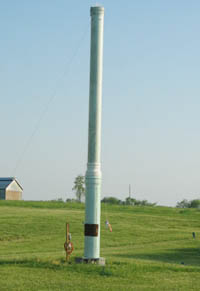Kentucky Joins North Central States in Monitoring the Flights of Soybean Aphid
Kentucky Joins North Central States in Monitoring the Flights of Soybean Aphid

Published on April 19, 2006
The University of Kentucky College of Agriculture corn/soybean working group, in partnership with the UK Integrated Pest Management program, has joined in the regional effort to monitor and explore the flight biology of the soybean aphid.
The soybean aphid feeds on the plant and is also capable of transmitting a number of viruses. In large numbers, the aphids can cause major damage in soybeans.
“Though the soybean aphid has been present in Kentucky every season since its discovery in 2000, it has yet to develop into the serious pest that it is in the upper Midwest,” said Doug Johnson, UK Extension entomologist. “While we hope that the aphid never develops as a serious pest in Kentucky, we cannot count on that outcome. Though we are sensitive to the dulling effect of ‘crying wolf,’ we are nevertheless compelled to keep up with this pest as it develops and changes in the United States.”
While it is not an important pest in the state, aphids are well known for their ability to adapt to new conditions.
“We do not want the aphid to show up in Kentucky at some future date, as a very ugly surprise,” Johnson said.
An aphid suction trap, located at the UK Research and Education Center in Princeton, has been set up and is functioning, he said. This trap is the most southerly of a 40-trap network that stretches from Kentucky to near the Canadian border, through the heart of the major soybean aphid infestation.
An aphid suction trap is a relatively simple device that allows the capture of aphids while they are flying. The trap is a set of pipes with a fan that draws in
air at one end and exhausts it out the other. Inside the pipe is a funnel-shaped screen that concentrates insects into a small “jar” that contains an insect preservative. Set up vertically to a height of about 24 feet, the trap sucks insects in at the top, pulls them through the funneling device into a collecting jar as it exhausts the air out the bottom of the pipe.
Perhaps more important than the trap is the ability to get the tiny insects identified, Johnson said. Critical to the trapping efforts is the cooperation of David Voegtlin, an aphid biologist with the Illinois Natural History Survey. Voegtlin and additional cooperators received a grant from the North Central IPM Center to support this project. Kentucky’s contribution, in part, will be to supply information on these aphids from the edge of their major distribution.
“This project is a good example of cooperative work among states, a regional IPM Center and the National IPM program,” Johnson said.
In addition to the soybean aphid project, the aphid trap has potential payback on other crops, he said. For example, it may be able to provide flight information on the grain aphid complex that infests Kentucky’s winter wheat crop. This will give UK’s Wheat Science Group, also a partner with the UK IPM program, knowledge on the flight biology of the grain aphids that potentially move barley yellow dwarf virus in the wheat crop.
